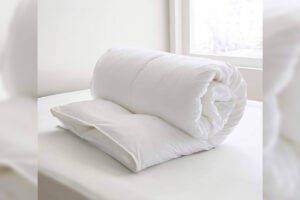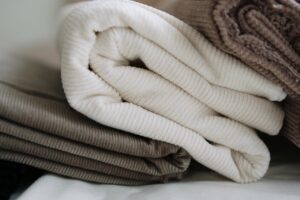Clothes alteration services are temporarily unavailable at all locations.
Does Dry Cleaning Remove Mould from Curtains? Here’s What You Should Know
- By White's Laundry
- 27 September 2025
Curtains don’t just frame your windows; they also trap dust, moisture, and airborne particles that build up over time. In humid climates or poorly ventilated rooms, this combination can quickly lead to one of the most common household issues: mould growth on curtains.
Besides looking unpleasant, mould can trigger allergies, worsen asthma, and create a persistent musty odour that lingers around the room. Understandably, many homeowners turn to professional cleaners for help. But the big question remains: does dry cleaning remove mould from curtains? Let’s find out.
Understanding Mould on Curtains
Mould thrives in damp, dark environments. Curtains hanging near windows, especially in bathrooms or kitchens, are constantly exposed to humidity and condensation. Over time, these areas become ideal breeding grounds for mould spores.
You’ll usually notice:
- Dark or greenish spots on the fabric
- A musty smell that doesn’t go away even after airing out the room
- Discolouration or stiff patches where the mould has settled
Certain curtain materials, such as thick drapes, lined curtains, or fabrics like velvet and wool, tend to hold more moisture and are therefore more prone to mould than lightweight, synthetic fabrics.
Does Dry Cleaning Remove Mould from Curtains?
The short answer: yes, dry cleaning can remove mould from curtains to a large extent. But there are a few important details to understand.
Dry cleaning uses chemical solvents instead of water to break down and remove dirt, oil, and organic growths like mould or mildew. During this process, the fabric is immersed in a cleaning solvent (commonly perchloroethylene or a hydrocarbon-based cleaner), which helps dissolve mould spores and eliminate odours without shrinking or damaging the material.
Here’s what dry cleaning can do:
- Remove surface-level mould and mildew effectively
- Eliminate musty smells caused by fungal growth
- Kill most mould spores, preventing further spread
- Preserve the colour, shape, and texture of delicate fabrics
However, the results depend on the extent of the mould growth. If mould has deeply penetrated multiple fabric layers or left behind stubborn stains, even professional dry cleaning may not restore the curtain completely.
When Dry Cleaning Is the Best Option
Dry cleaning is the safest and most effective choice in several situations.
1. Delicate or Non-Washable Fabrics
Curtains made from silk, velvet, or wool blends can shrink, fade, or lose texture when washed in water. For these materials, dry cleaning is the only recommended method.
2. Moderate Mould Growth
If the mould is visible but not extensive (small patches or mild odour), a professional dry cleaner can usually remove it completely with pre-treatment and solvent cleaning.
3. Professional Finish
Dry cleaning not only removes mould but also presses, restores, and deodorizes your curtains, giving them a crisp, fresh look that’s hard to achieve with home washing.
When Dry Cleaning May Not Be Enough
There are times when even the best dry cleaning process can’t fully solve a mould problem.
- Severe or deep-set mould: If the spores have penetrated into the curtain lining or backing fabric, solvents may not reach those areas completely.
- Visible stains that remain after cleaning: Some mould can cause permanent fabric discolouration.
- Recurring mould problems at home: If humidity or condensation issues persist, the mould will simply return no matter how well the curtains are cleaned.
In these cases, combining dry cleaning with professional mould treatment or addressing moisture sources at home becomes essential.
Alternative Methods for Mould Removal (for Washable Curtains)
If your curtains are labelled machine washable, you can try gentler home treatments before professional cleaning. Always check the care label first.
1. Machine Wash with Vinegar
Add one cup of white vinegar to the wash cycle to help kill mould spores and remove odour. Use warm water (not hot) and air dry in sunlight.
2. Baking Soda Soak
For lighter fabrics, soak curtains in warm water mixed with baking soda for an hour before washing. This helps neutralize musty smells.
3. Steam Cleaning
A handheld steam cleaner can help sanitize fabric and loosen surface mould, especially for heavy drapes that can’t be easily removed.
These methods work for mild mould buildup, but for extensive mould growth or delicate materials, professional dry cleaning remains the safer option.
How Professional Curtain Cleaners Handle Mould
Experienced curtain cleaning specialists don’t just run your curtains through a standard dry-clean cycle. Here’s what typically happens when you bring mould-affected curtains to a professional dry cleaner:
- Inspection and Fabric Assessment: The cleaner examines the curtain type, mould severity, and care label instructions.
- Pre-Treatment of Mould Spots: Problem areas are treated with mild antifungal or stain-removing agents before dry cleaning.
- Solvent-Based Dry Cleaning: Curtains are immersed in specialized solvents that dissolve and sanitize mould.
- Odour Neutralization: A deodorizing step removes any lingering musty smell.
- Professional Pressing and Packaging: Curtains are pressed, inspected, and returned ready to hang – clean, fresh, and mould-free.
This careful process ensures your curtains are not only cleaned but also preserved, extending their lifespan.
Preventing Mould from Returning
After cleaning, prevention is key. Follow these tips to keep mould from coming back:
- Improve air circulation: Use exhaust fans or open windows regularly.
- Let sunlight in: Natural light helps keep fabrics dry.
- Avoid damp areas: Keep curtains away from bathroom or kitchen moisture whenever possible.
- Regular cleaning: Have curtains professionally cleaned every 6–12 months.
- Address humidity: Use a dehumidifier or moisture absorber in rooms prone to condensation.
By pairing dry cleaning with good home maintenance, you can keep your curtains mould-free for much longer.
Conclusion
So, does dry cleaning remove mould from curtains? Yes. In most cases, professional dry cleaning can effectively eliminate mould, odours, and spores without damaging your curtains. However, for severe infestations or ongoing moisture issues, extra steps like mould treatment or humidity control are necessary.
If your curtains show signs of mould, don’t wait. The longer you delay, the deeper the mould sets in, and the harder it becomes to remove. Get your curtains professionally cleaned and preserved today to protect both your home and your health.




